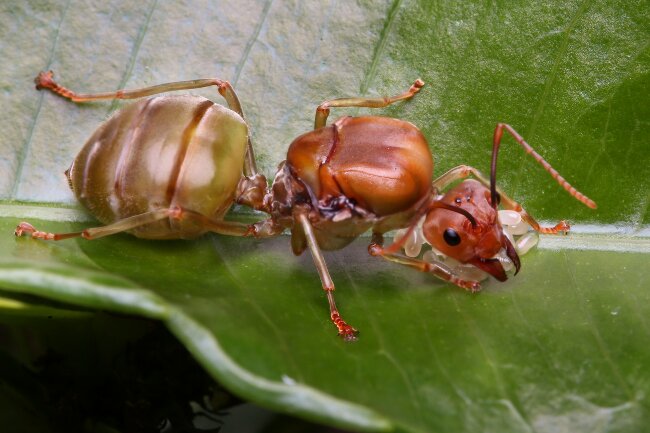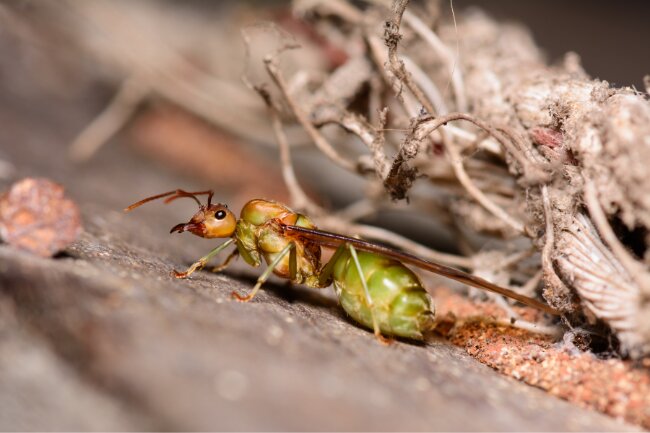In most species, ants are born as queens, rather than being chosen. A queen is the only female within her nest that can reproduce. In some species, ordinary worker ants can change into queens when the queen dies.
Contents
What do queen ants look like?

The queen is the largest ant within a colony, much bigger than the male. In most species, when she emerges she has wings, unlike the other females.
Once she sets up her nest, she will cut off her wings and begin to lay eggs. Her abdomen will swell, which can make it more difficult for her to move.
| Type of Queen | Description |
|---|---|
| Founding Queens | Establish new colonies by starting a nest and laying the first batch of eggs |
| Ergatoid Queens | Workers that have the potential to become queens and can take over reproductive duties |
| Parasitic Queens | Invade existing colonies, eliminate the resident queen, and take over the reproductive role |
| Temporary Queens | Appointed from worker ants in the absence of a queen and can temporarily lay eggs and reproduce |
Also read: “Do Ants have Wings?” What is Their Function?
How long do queen ants live?
We tend to think of insects as having relatively short lifespans, from insects that live a day to those that last summer. However, a surprising number of insects can live many years, and even over a decade.
Within a colony, the age an ant will reach depends massively on what caste and sex the ant is. Males are the shortest-lived, often living only a few days or a week. Workers are next, these live around five years in many species.
| Development Stage | Description |
|---|---|
| Larval Stage | After hatching from an egg, the larva is cared for and fed by worker ants to support its growth |
| Pupal Stage | The larva undergoes metamorphosis inside a cocoon-like structure, transforming into an adult queen |
| Mating Flight | Once fully developed, the queen participates in a mating flight to mate with male ants |
| Colony Establishment | The mated queen starts a new colony, builds a nest, and begins laying eggs to establish the population |
The queen by comparison has been found to live 15 years, with some being found to be 30 years old. This longer life is probably in part because she spends much of her time in the safety of the nest and is fed and cared for by her workers.
When do queen ants come out of the nest?

The life of a queen starts in the nest of her mother, where she is born and grows into a larva and then an adult. At this stage, she is booted out and must leave the colony to go and mate.
Her wings, which the other females do not possess, allow her to fly away and set up and the new nest. Having found a suitable spot she will dig into the ground and begin laying eggs, these will be her workers.
Once she is set up with workers to go out and forage for her, she won’t leave the nest unless some kind of disaster occurs, staying safe within the belly of her home.
In some ant species, however, mobility is more of a requirement. For example, in species that live in areas that seasonally flood, queens will regularly have to abandon ship and leave the nest with their workers. Some ant species also move the nest regularly, such as rock ants.
During emigrations, rock ants will only bring the queen out of the safety of the nest when half the colony has moved to the new site, half having remained behind to care for the queen in the old nest. Due to the queen’s large size, she will often need to be carried by workers, unable to move long distances.
Army ants and driver ants have a slightly different lifestyle to many nest forming ants. Because they are frequently on the move, they set up temporary nests, known as bivouacs. The bivouac is made up of the bodies of the worker ants, holding onto one another with their jaws. The queen will always be situated at the centre of the bivouac, as this is the safest place for her to be.
For many species of ants, losing their queen is catastrophic for the colony, meaning that they will always do everything they can to protect her.
Also read: “Do Ants Have Wings?” What is Their Function?
How do queen ants reproduce?
Queen ants lay the eggs that become the other ants within her nest; the workers, drones and other queens. In most ant colonies, she will be the only female capable of producing young. Having been born as a queen, with different anatomy to her sisters, she will then need to mate with a male to begin producing young.
In order to mate, she will leave the nest and perform a nuptial flight, where virgin queens and drones congregate in order to mate. The males won’t survive long after this flight, but the female will carry the sperm passed onto her within her body, so she can fertilise the eggs she produces over the following years.
Although this is a common method of reproduction for many queen ants, some ant species do things differently. In army ants, for example, the queen does not take a nuptial flight, instead, she remains within the nest and drones come to her to mate with her.
Once she has mated, she will take some of the workers within the colony and set out to start a new nest. It seems that she mates with several drones in order to have a mixture of semen to use as she lays eggs.
Do queen ants need a male?
Some ant species are able to reproduce asexually, meaning that they produce clones of themselves. This is the case in some desert ant species. However, it will mean they can only produce females.
Additionally, ants produce fertilised and unfertilised eggs when they are laying. Fertilised eggs become females, so either queens or workers, whereas unfertilised eggs become males. The female doesn’t seem to start producing males until after she has mated, however.
How do they defend themselves?

In general, queen ants do not defend themselves. This is because they have an entire colony to do it for them. While queens do have jaws, so technically could bite, and can have stings, they are very much focused on their reproductive activities and leave defending the nest, and procuring food, to their many helpers.
The queen’s main form of defence is simply not to be seen. In most species, she will spend nearly her entire life hidden underground, or surrounded by her workforce. Ants are species that have learnt to carefully divide tasks among the various members of the colony to ensure they are carried out efficiently, and the queens are simply to reproduce and survive.
Also read: Do Ants Bite or Sting? Do They Have Teeth? (FAQ)
How long do ants live without a queen?
For most species of ants, the loss of a queen is a death toll. It’s for this reason they put so much work into looking after her. The queen can live for 15 to 30 years, whereas each worker will only last around 5 years. Without a queen to produce new young, the colony will quickly lose workers until it no longer functions.
Not all species simply succumb to the loss of their queen, though. In army ants, the colony will try to find and join with a sister colony, one where the queen is related to the queen they have lost. As new army ant colonies are created by fission, where a young queen takes workers from her mother’s nest and sets off to create a new colony, this isn’t an impossible task.
Pharaoh ants are a species that have many queens within a nest at one time. The young queens will go off to form new colonies, however, if a queen is lost then new queen larvae can be reared to replace her, or a queen larvae can be taken from a sister colony to be raised.
Fascinatingly, in Indian jumping ants, a worker can become a queen if the queen dies. When the throne is empty, the workers hold a kind of game where each of the workers fights her sisters while growing her ovaries to be ready to reproduce.
The winner will then be selected and become the new queen of the colony. If more than one ant becomes reproductive at the same time, the other ants will hold her until she loses her reproductive ability and becomes an ordinary worker again.
A queens rule
While we may think of the queen as the head of her nest, she is only as strong as the workers who support her. They feed and protect her, and help raise their siblings. The queen may be the lynchpin of the nest, but there is no nest without her subjects.

